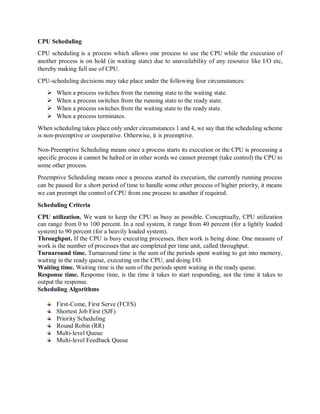Denunciar
Compartir
Descargar para leer sin conexión

Recomendados
Más contenido relacionado
La actualidad más candente
La actualidad más candente (20)
Similar a Cpu scheduling
Similar a Cpu scheduling (20)
Operating Systems Third Unit - Fourth Semester - Engineering

Operating Systems Third Unit - Fourth Semester - Engineering
LM10,11,12 - CPU SCHEDULING algorithms and its processes

LM10,11,12 - CPU SCHEDULING algorithms and its processes
Más de A. S. M. Shafi
Más de A. S. M. Shafi (20)
Último
https://app.box.com/s/7hlvjxjalkrik7fb082xx3jk7xd7liz3TỔNG ÔN TẬP THI VÀO LỚP 10 MÔN TIẾNG ANH NĂM HỌC 2023 - 2024 CÓ ĐÁP ÁN (NGỮ Â...

TỔNG ÔN TẬP THI VÀO LỚP 10 MÔN TIẾNG ANH NĂM HỌC 2023 - 2024 CÓ ĐÁP ÁN (NGỮ Â...Nguyen Thanh Tu Collection
Último (20)
Ecological Succession. ( ECOSYSTEM, B. Pharmacy, 1st Year, Sem-II, Environmen...

Ecological Succession. ( ECOSYSTEM, B. Pharmacy, 1st Year, Sem-II, Environmen...
General Principles of Intellectual Property: Concepts of Intellectual Proper...

General Principles of Intellectual Property: Concepts of Intellectual Proper...
Web & Social Media Analytics Previous Year Question Paper.pdf

Web & Social Media Analytics Previous Year Question Paper.pdf
Micro-Scholarship, What it is, How can it help me.pdf

Micro-Scholarship, What it is, How can it help me.pdf
TỔNG ÔN TẬP THI VÀO LỚP 10 MÔN TIẾNG ANH NĂM HỌC 2023 - 2024 CÓ ĐÁP ÁN (NGỮ Â...

TỔNG ÔN TẬP THI VÀO LỚP 10 MÔN TIẾNG ANH NĂM HỌC 2023 - 2024 CÓ ĐÁP ÁN (NGỮ Â...
Mixin Classes in Odoo 17 How to Extend Models Using Mixin Classes

Mixin Classes in Odoo 17 How to Extend Models Using Mixin Classes
On National Teacher Day, meet the 2024-25 Kenan Fellows

On National Teacher Day, meet the 2024-25 Kenan Fellows
Seal of Good Local Governance (SGLG) 2024Final.pptx

Seal of Good Local Governance (SGLG) 2024Final.pptx
Beyond the EU: DORA and NIS 2 Directive's Global Impact

Beyond the EU: DORA and NIS 2 Directive's Global Impact
ICT Role in 21st Century Education & its Challenges.pptx

ICT Role in 21st Century Education & its Challenges.pptx
Cpu scheduling
- 1. CPU Scheduling CPU scheduling is a process which allows one process to use the CPU while the execution of another process is on hold (in waiting state) due to unavailability of any resource like I/O etc, thereby making full use of CPU. CPU-scheduling decisions may take place under the following four circumstances: When a process switches from the running state to the waiting state. When a process switches from the running state to the ready state. When a process switches from the waiting state to the ready state. When a process terminates. When scheduling takes place only under circumstances 1 and 4, we say that the scheduling scheme is non-preemptive or cooperative. Otherwise, it is preemptive. Non-Preemptive Scheduling means once a process starts its execution or the CPU is processing a specific process it cannot be halted or in other words we cannot preempt (take control) the CPU to some other process. Preemptive Scheduling means once a process started its execution, the currently running process can be paused for a short period of time to handle some other process of higher priority, it means we can preempt the control of CPU from one process to another if required. Scheduling Criteria CPU utilization. We want to keep the CPU as busy as possible. Conceptually, CPU utilization can range from 0 to 100 percent. In a real system, it range from 40 percent (for a lightly loaded system) to 90 percent (for a heavily loaded system). Throughput. If the CPU is busy executing processes, then work is being done. One measure of work is the number of processes that are completed per time unit, called throughput. Turnaround time. Turnaround time is the sum of the periods spent waiting to get into memory, waiting in the ready queue, executing on the CPU, and doing I/O. Waiting time. Waiting time is the sum of the periods spent waiting in the ready queue. Response time. Response time, is the time it takes to start responding, not the time it takes to output the response. Scheduling Algorithms First-Come, First Serve (FCFS) Shortest Job First (SJF) Priority Scheduling Round Robin (RR) Multi-level Queue Multi-level Feedback Queue
- 2. First-Come, First-Served Scheduling Its implementation is based on FIFO queue. Process arrives first always execute first. FCFS is non-preemptive scheduling algorithm so processes priority does not matter. FCFS is pre-emptive scheduling algorithm. If process first arrived is a big process with a high burst time, then other process with less burst time need to wait. Average wait time is high. Easy to implement. Easy to understand. Consider the following set of processes that arrive at time 0, with the length of the CPU burst given in milliseconds: If the processes arrive in the order P1, P2, P3, and are served in FCFS order, we get the result shown in the following Gantt chart, which is a bar chart that illustrates a particular schedule, including the start and finish times of each of the participating processes: The waiting time is 0 milliseconds for process P1, 24 milliseconds for process P2, and 27 milliseconds for process P3. Thus, the average waiting time is (0 + 24 + 27)/3 = 17 milliseconds. If the processes arrive in the order P2, P3, P1, however, the results will be as shown in the following Gantt chart: The average waiting time is now (6 + 0 + 3)/3 = 3 milliseconds. This reduction is substantial. Thus, the average waiting time under an FCFS policy is generally not minimal and may vary substantially if the processes’ CPU burst times vary greatly.